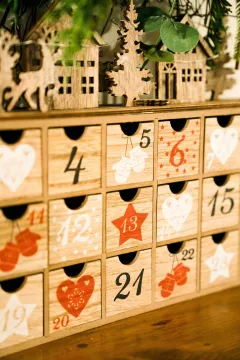Learn about the origins of the Advent Calendar

Advent calendars are a very old tradition that consists of preparing for the arrival of baby Jesus on December 25. It is a very nice way to remember the importance of love and solidarity during these significant dates.
This tradition dates back to Roman times. Back then, the advent period was a time for celebration and jubilation, as it was the time when the birth of baby Jesus was expected. Over the centuries, this tradition has evolved and taken new forms.
In Roman times, they used a variation of the lunar calendar to measure time. This Roman calendar had a four-year cycle and began with the first day of spring, March 21. Each year, the calendar moved forward 11 days, which meant that, at a certain point, the Roman calendar and the solar calendar were synchronizing.
In the mid-16th century, Pope Gregory XIII introduced a new calendar, called the Gregorian calendar, which corrected the error of the Roman calendar and synchronized it with the solar calendar. This calendar is used in most countries of the world today.
The Gregorian calendar has 12 months, each with a certain number of days. However, the year has an extra day, or leap, every four years to make up for small errors in the calendar. This means that the year has a total of 365.25 days.
The Gregorian calendar also established January 1 as the first day of the year. This is because the Roman calendar started on March 1, but Pope Gregory decided that January 1 would be the first day of the year.
Although the Gregorian calendar is the official calendar of the Catholic Church, it is not the only religious calendar. The Jewish calendar, for example, begins on October 5, 5781, while the Muslim calendar begins on August 24, 1442.
Advent calendars are generally used to mark the time remaining until Christmas. However, the exact origin of the advent calendar is somewhat controversial. Some people believe that it was created by the early Christians as a way to celebrate the arrival of the Messiah, while others believe that it was invented much later, during the 18th or even the 19th century.
Although it is not known for certain when advent calendars were created, however, there are several indications that their history is ancient. History and research experts have found several references to advent calendars in 14th century European documents. One of these references is found in the book "Horae Beatae Virginis" (The Hours of the Virgin), which was written by the Franciscan religious Jean Meschinot in 1324.
In this book, Meschinot described a calendar used by monks to mark the weeks before Christmas Day. Apparently, this calendar was very similar to one of the designs of modern advent calendars. Currently, advent calendars usually consist of a series of boxes or boxes numbered from 1 to 24, in which different objects or gifts are placed. Every day during the month leading up to Christmas, a box is opened and the content is obtained.
Keeping traditions alive throughout history is very important for humanity. It is what enriches us as a species and helps us maintain a link with our culture. Traditions are practices that we regularly carry out and that are part of our cultural heritage. Learning new ways to make them is always interesting, especially if we can share them with our loved ones. Something that you can also do if you are going to take a trip soon with a host family in Dublin, it is a beautiful tradition to share with them.
How could time pass without an advent calendar to mark the days until Christmas? For many, this is the only way to know how long until Three Kings Day arrives. However, did you know that advent calendars have a much older and more mysterious origin?
Today, there are various types of advent calendars: from the simplest to the most sophisticated. Advent calendars are a way to mark the time until Christmas. There are different types of advent calendars, from the simplest, which only have a number for each day, to the most elaborate, which include a figure or toy for each day.
In Ireland, for example, there are several traditions related to advent calendars. The best known is the so-called "Gresca", which takes place on December 24. It is a kind of pre-Christmas party in which the whole family gathers to sing Christmas carols, dance and enjoy a delicious typical Irish dish.
Another very interesting tradition is "The King's Dinner", which is celebrated on January 5 and consists of preparing a great meal for all family members, friends and neighbors. On this occasion, children usually bring small gifts to the elders to thank them for everything they do for them during the rest of the year. If you cannot spend these dates in Ireland, we recommend you stay in some English colonies to be able to live this beautiful experience.
Finally, I would highlight the tradition of the "Celtiberian New Year". It is actually a mixed set between pagan and Christian customs, since it is celebrated on January 1. It is believed that on this date the spirits of the ancestors visit their relatives to wish them a prosperous New Year. Oddly enough, people often prepare large banquets for them and leave plates full of food on the table.
In conclusion, we can say that advent calendars are a very beautiful and special tradition that helps us remember what is truly important during these significant dates of the year. So you already know! Advent calendars not only serve to mark the days until Christmas, but also have a mysterious and ancient origin. Happy Advent!